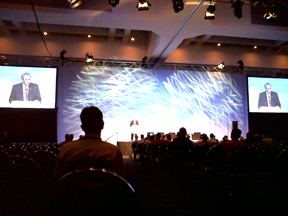
CEDIA Chief Executive Officer Utz Baldwin addresses the audience at the Annual Membership Meeting and Keynote Panel at CEDIA EXPO 2010.
The event included 453 total exhibitors, an increase of 6 percent over 2009. Of those exhibitors, 90 were making their first appearance at CEDIA EXPO. The tradeshow covered a total of 232,515 net square feet of exhibit space. With more than 20,700 attendees, attendance held steady with modest growth from 2009-2010, which is a huge improvement after 2009’s 12 percent drop. Nearly 20 percent of attendees were first-time visitors to CEDIA EXPO.
No doubt, change was in the air in Atlanta. “The steady booth traffic, the increase in exhibiting companies, and the number of new attendees are all early indicators that our industry is poised for a resurgence,” comments CEDIA Chief Executive Officer Utz Baldwin. At the event, the association introduced new member benefits and initiatives designed to support the continued growth of the industry in the face of a continually changing market.
One growing change, energy management, was addressed in the Annual Membership Meeting and Keynote Panel. Energy management is a growing trend that all electronic systems contractors need to stay constantly informed in order to proactively meet customer needs. According to Park Associates, 80 percent of U.S. households are interested in learning more about how to cut their energy costs.
Moderated by Bill Ablondi, Parks Associates, director, Home Systems Research, the panelists included: Collin Breakstone, Control4 Energy Systems, director, Business Development; Jesse Berst, GlobalSmartEnergy, managing director; Chris Deutschen, Direct Energy, senior manager innovation and business development; Fiona Sim, Intel Corp., director of Intel Open Energy Initiative; Jay McLellan, Home Automation Inc. (HAI), president and chief executive officer. They all delivered their thoughts on the “state of the union” as it relates to energy management and the electronic systems industry.
It is just one more change in an evolving industry, and the changes are not about to stop. “Throughout the years, the products, services, and business models of our members have evolved,” adds Baldwin. “These businesses evolved to capitalize on opportunities, and as technology proliferates further into the home, these ESCs — along with the manufacturing community and all those who work in the industry — will undoubtedly continue to evolve in the years to come.”
So will CEDIA. The changes and new initiatives from CEDIA include:
• In 2011, CEDIA will launch a comprehensive industry-wide market research program. The association will gather data to help determine the true scope of the electronic systems industry relating to size, legislative and financial impact, convergence trends, consumer and industry partner awareness and adoption, and opportunities and threats.
• CEDIA will launch several special interest groups that will enable manufacturers with common interests to communicate their marketing and channel development needs to the association. The first of these groups include an industry outreach group, which will focus on marketing to architects, designers, builders, and other industry partners; a performance entertainment group, which will help raise awareness of high performance audio/visual solutions; and a retrofit technologies group, which will focus on residential technologies such as powerline, wireless, and other alternative transmission platforms.
• CEDIA is creating a new council structure that will organize its members based on business model. The new structure will provide a platform for networking and sharing ideas with peers and communicating needs to the association. This new bottom-up approach will ensure that CEDIA develops compelling products and services that are valuable and relevant.
Electronic systems contractors (ESCs) attending the event also were seeking diversification strategies. “Dealers came looking for solutions to grow past their core business,” observes Randy Blanchard, program marketing manager, ADI, the Melville, N.Y.-based low voltage distributor. “CEDIA EXPO offered many solutions in adjacent markets. ADI’s strength is offering solutions in multiple categories, so for us this show was a success. We look forward to seeing everyone in Indy in 2011.”
After having spent two years in Atlanta, CEDIA EXPO will move to the Indiana Convention Center in Indianapolis for next year’s show, which will be held Sept. 7–11, 2011. Additional information will be available soon at www.cedia.org/expo.




